The Interventional X - ray Systems Market is estimated to be valued at USD 2.7 billion in 2025 and is projected to reach USD 5.5 billion by 2035, registering a compound annual growth rate (CAGR) of 7.5% over the forecast period.
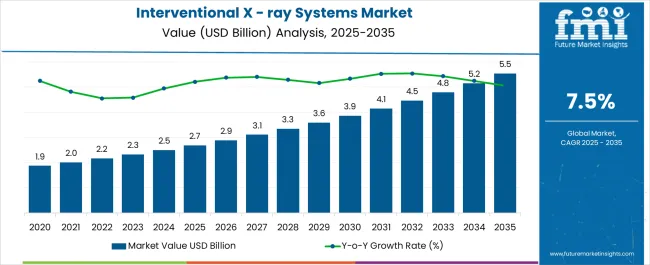
| Metric | Value |
|---|---|
| Interventional X - ray Systems Market Estimated Value in (2025 E) | USD 2.7 billion |
| Interventional X - ray Systems Market Forecast Value in (2035 F) | USD 5.5 billion |
| Forecast CAGR (2025 to 2035) | 7.5% |
The Interventional X-ray Systems market is experiencing steady growth driven by the increasing adoption of minimally invasive procedures and the rising prevalence of cardiovascular and vascular diseases. The market is being propelled by technological advancements in imaging, including real-time visualization, high-resolution detectors, and software-driven enhancements that allow precise guidance during interventions. Hospitals and specialty clinics are prioritizing these systems due to their ability to improve procedural accuracy, reduce patient risk, and shorten recovery times.
Increasing investments in healthcare infrastructure, particularly in emerging markets, have also contributed to market expansion. Growing awareness among healthcare professionals regarding the benefits of interventional procedures and the need for efficient workflow management has further fueled adoption.
The trend toward hybrid operating rooms and the integration of advanced imaging with robotic and AI-assisted interventions is expected to create additional growth opportunities As global healthcare systems focus on cost-effective, patient-centered care, Interventional X-ray Systems are anticipated to maintain strong demand with sustained growth potential across both developed and developing regions.
The interventional x - ray systems market is segmented by product type, applications, end users, and geographic regions. By product type, interventional x - ray systems market is divided into Fixed Interventional X – Ray Systems, Single Plane Interventional X – Ray Systems, Bi-Plane Interventional X – Ray Systems, Surgical C-Arm Interventional X – Ray Systems, Mobile Interventional X – Ray Systems, and Mini C-Arm Interventional X – Ray Systems.
In terms of applications, interventional x - ray systems market is classified into Cardiology, Neurology, Oncology, and Pediatric. Based on end users, interventional x - ray systems market is segmented into Hospitals, Research Institutes, Diagnostic Centers, and Others. Regionally, the interventional x - ray systems industry is classified into North America, Latin America, Western Europe, Eastern Europe, Balkan & Baltic Countries, Russia & Belarus, Central Asia, East Asia, South Asia & Pacific, and the Middle East & Africa.
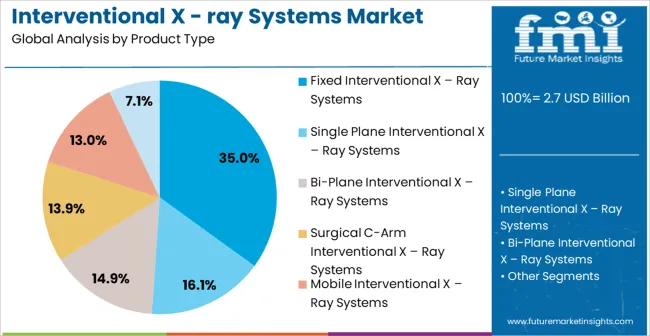
The Fixed Interventional X-ray Systems segment is projected to hold 35.00% of the Interventional X-ray Systems market revenue in 2025, establishing it as the leading product type. This dominance is being attributed to its robustness, high image quality, and suitability for complex procedures that require stable positioning and precise imaging over extended periods. Fixed systems provide enhanced workflow efficiency in hospitals and interventional suites where frequent high-risk procedures are performed.
The integration of advanced software modules enables real-time imaging enhancements and precise anatomical guidance, reducing procedural errors and improving patient outcomes. The demand for fixed systems is further strengthened by hospital investments in long-term infrastructure and the preference for equipment with proven reliability.
Additionally, the ability to support hybrid operating rooms and compatibility with a range of interventional tools has reinforced the segment’s market leadership Future growth is expected to be supported by the rising adoption of minimally invasive procedures and the increasing need for high-performance, software-enhanced imaging platforms in clinical environments.
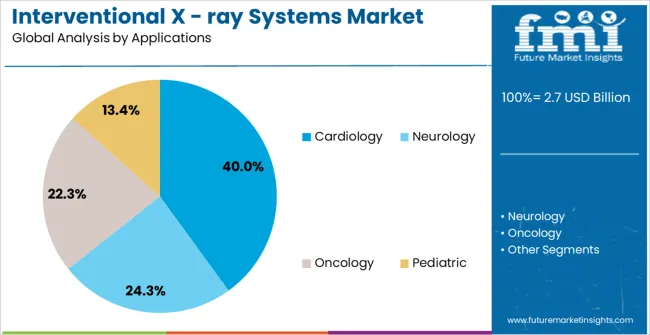
The Cardiology application segment is anticipated to capture 40.00% of the Interventional X-ray Systems market revenue in 2025, making it the largest application area. This leadership position is being driven by the global rise in cardiovascular disease prevalence and the increased adoption of minimally invasive cardiac interventions, including angioplasty, stent placement, and electrophysiological procedures.
Software-driven imaging enhancements in Interventional X-ray Systems enable accurate real-time visualization of cardiac anatomy, facilitating precise interventions and reducing procedural complications. Hospitals and specialized cardiac centers are increasingly deploying these systems to improve patient outcomes while maintaining operational efficiency.
The integration of advanced imaging with patient monitoring, AI-assisted analysis, and procedural guidance tools further reinforces the segment’s growth As awareness of preventive cardiology and interventional techniques continues to expand, the Cardiology segment is expected to remain a major revenue contributor, supported by healthcare infrastructure investments and a growing number of interventional procedures worldwide.
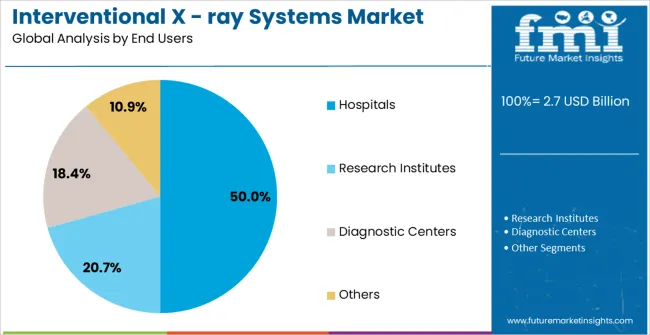
The Hospitals end-user segment is projected to hold 50.00% of the Interventional X-ray Systems market revenue in 2025, making it the dominant consumer group. This leadership is being attributed to the concentration of interventional procedures within hospital settings, where advanced imaging infrastructure, trained personnel, and high patient volumes create optimal conditions for system utilization. Hospitals prioritize high-quality, reliable imaging platforms that support a wide range of procedures, from cardiology to vascular and orthopedic interventions.
The ability to upgrade software and integrate imaging with hospital information systems enhances operational efficiency and reduces long-term costs. Increasing investments in modern healthcare facilities and the expansion of interventional cardiology and radiology departments are further supporting demand.
Hospitals benefit from improved patient safety, reduced procedure times, and higher procedural success rates enabled by software-driven interventional X-ray systems With the continuing emphasis on minimally invasive care and technological modernization, hospitals are expected to maintain their leading position in market adoption, driving sustained growth across this segment.
Interventional X – Ray Systems can be defined as a medical device. Where X – Ray systems used for the monitoring the interventional procedure used during interventional neurology, interventional cardiology or any other interventional procedure.
The rising technological improvements in Interventional X – Ray Systems have been observed in the past few years. The evolution of Interventional X – Ray has opened the scope of minimally invasive diagnosis and treatment.
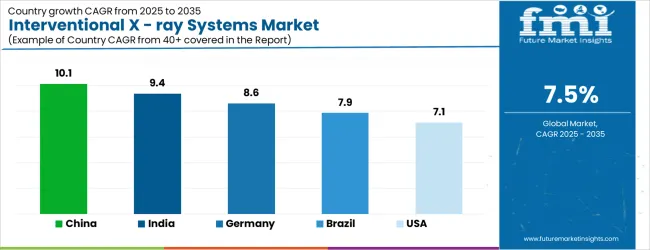
| Country | CAGR |
|---|---|
| China | 10.1% |
| India | 9.4% |
| Germany | 8.6% |
| Brazil | 7.9% |
| USA | 7.1% |
| UK | 6.4% |
| Japan | 5.6% |
The Interventional X - ray Systems Market is expected to register a CAGR of 7.5% during the forecast period, exhibiting varied country level momentum. China leads with the highest CAGR of 10.1%, followed by India at 9.4%. Developed markets such as Germany, France, and the UK continue to expand steadily, while the USA is likely to grow at consistent rates. Japan posts the lowest CAGR at 5.6%, yet still underscores a broadly positive trajectory for the global Interventional X - ray Systems Market. In 2024, Germany held a dominant revenue in the Western Europe market and is expected to grow with a CAGR of 8.6%. The USA Interventional X - ray Systems Market is estimated to be valued at USD 920.5 million in 2025 and is anticipated to reach a valuation of USD 920.5 million by 2035. Sales are projected to rise at a CAGR of 0.0% over the forecast period between 2025 and 2035. While Japan and South Korea markets are estimated to be valued at USD 128.0 million and USD 90.6 million respectively in 2025.
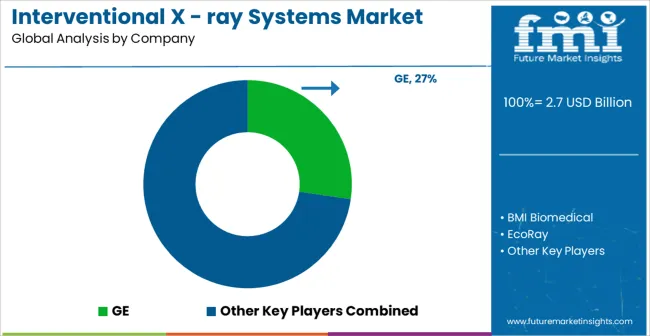
| Item | Value |
|---|---|
| Quantitative Units | USD 2.7 Billion |
| Product Type | Fixed Interventional X – Ray Systems, Single Plane Interventional X – Ray Systems, Bi-Plane Interventional X – Ray Systems, Surgical C-Arm Interventional X – Ray Systems, Mobile Interventional X – Ray Systems, and Mini C-Arm Interventional X – Ray Systems |
| Applications | Cardiology, Neurology, Oncology, and Pediatric |
| End Users | Hospitals, Research Institutes, Diagnostic Centers, and Others |
| Regions Covered | North America, Europe, Asia-Pacific, Latin America, Middle East & Africa |
| Country Covered | United States, Canada, Germany, France, United Kingdom, China, Japan, India, Brazil, South Africa |
| Key Companies Profiled | GE, BMI Biomedical, EcoRay, EMD Medical Technologies, Eurocolumbus, Hologic, Intermedical, Medtronic, Philips, Siemens, Stephanix, Shimadzu, and Ziehm Imaging |
The global interventional x - ray systems market is estimated to be valued at USD 2.7 billion in 2025.
The market size for the interventional x - ray systems market is projected to reach USD 5.5 billion by 2035.
The interventional x - ray systems market is expected to grow at a 7.5% CAGR between 2025 and 2035.
The key product types in interventional x - ray systems market are fixed interventional x – ray systems, single plane interventional x – ray systems, bi-plane interventional x – ray systems, surgical c-arm interventional x – ray systems, mobile interventional x – ray systems and mini c-arm interventional x – ray systems.
In terms of applications, cardiology segment to command 40.0% share in the interventional x - ray systems market in 2025.






Full Research Suite comprises of:
Market outlook & trends analysis
Interviews & case studies
Strategic recommendations
Vendor profiles & capabilities analysis
5-year forecasts
8 regions and 60+ country-level data splits
Market segment data splits
12 months of continuous data updates
DELIVERED AS:
PDF EXCEL ONLINE
Interventional Radiology Product Market Size and Share Forecast Outlook 2025 to 2035
Interventional Radiology Market Growth - Trends & Forecast 2025 to 2035
Interventional Cardiology Devices Market Size and Share Forecast Outlook 2025 to 2035
Neurointerventional Device Market Analysis - Size, Share, and Forecast Outlook 2025 to 2035
Nonvascular Interventional Radiology Device Market Trends – Growth & Forecast 2024-2034
XEDS Detectors Market Size and Share Forecast Outlook 2025 to 2035
Xylose Market Size and Share Forecast Outlook 2025 to 2035
Xylooligosaccharide Market Size and Share Forecast Outlook 2025 to 2035
Xylitol Market Size and Share Forecast Outlook 2025 to 2035
XXL Packaging Market Size and Share Forecast Outlook 2025 to 2035
Xanthan Gum Market Analysis by Function, Form, Application, Grade and Region Through 2035
Xylanase Market Analysis - Size, Share & Forecast 2025 to 2035
Ximenia Oil Market Analysis by Function, Distribution Channel, End Use, and Region through 2025 to 2035
Competitive Overview of Xylenols Market Share
Xenon Gas Market Growth - Trends & Forecast 2024 to 2034
Xylose Absorption Tests Market
XRF Analyzer Market Growth – Trends & Forecast 2019-2027
X-Band Radar Market Size and Share Forecast Outlook 2025 to 2035
X-by-Wire Market Growth – Trends & Forecast 2025 to 2035
X-Arm Type Window Regulator Market

Thank you!
You will receive an email from our Business Development Manager. Please be sure to check your SPAM/JUNK folder too.
Chat With
MaRIA